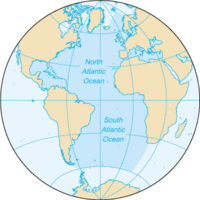
Photo from wikipedia
In this study, we analyzed the main distributional features of Scolecitrichidae species in the Southwestern Atlantic Ocean (northern region of Rio de Janeiro State) and determined and described their habitat… Click to show full abstract
In this study, we analyzed the main distributional features of Scolecitrichidae species in the Southwestern Atlantic Ocean (northern region of Rio de Janeiro State) and determined and described their habitat partitioning, based on a night series of stratified samplings down to a depth of 1,200 m. A total of 18 species from seven genera were identified and grouped according to their depth distribution. Distinct vertical patterns of total density, richness, diversity, and evenness were observed, with a decrease in density and an increase in diversity and richness with increasing depth. The total scolecitrichid abundance was dominated by a few epipelagic migrant species (Scolecithrix danae, Scolecithricella minor, Amallothrix tenuiserrata, and Lophothrix frontalis). The nondominant species were distributed in different habitats in the mesopelagic layer (upper-mesopelagic, mesopelagic, and lower-mesopelagic species) according to their vertical patterns of abundance and occurrence in the two sampling periods (rainy and dry season). The total density of scolecitrichid copepods was positively related to temperature and nitrate, and negatively related to silicate at 1 m depth. The abundance of scolecitrichids copepods in the upper layer with warm and oligotrophic waters supports the hypothesis of the influence of different water masses on the scolecitrichid assemblage. High abundance of appendicularians (Oikopleura longicauda) at 1 m depth in the region implies a high production rate of discarded "houses", an important dietary component for Scolecitrichidae copepods. The observed patterns of seasonal cycles and vertical distribution suggest that the diverse scolecitrichid assemblage in the region may be structured mainly according to the partitioning of vertical habitats and food resources.
Journal Title: Anais da Academia Brasileira de Ciencias
Year Published: 2019
Link to full text (if available)
Share on Social Media: Sign Up to like & get
recommendations!